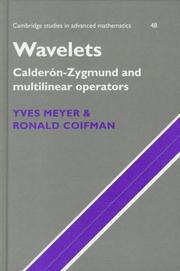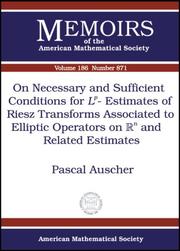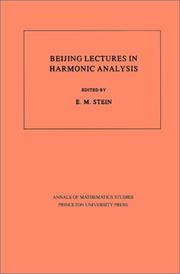| Listing 1 - 10 of 15 | << page >> |
Sort by
|
Book
Year: 1971 Publisher: Technische Hochschule Wien : Institut fur stahlbau,
Abstract | Keywords | Export | Availability | Bookmark
 Loading...
Loading...Choose an application
- Reference Manager
- EndNote
- RefWorks (Direct export to RefWorks)
Book
Year: 1979 Publisher: Paris : Université Pierre et Marie Curie [Paris VI],
Abstract | Keywords | Export | Availability | Bookmark
 Loading...
Loading...Choose an application
- Reference Manager
- EndNote
- RefWorks (Direct export to RefWorks)
Fluid mechanics. --- Singular integral equations --- Unsteady flow
Book
ISBN: 3110250314 9783110250312 9783110250305 Year: 2012 Publisher: Berlin : De Gruyter,
Abstract | Keywords | Export | Availability | Bookmark
 Loading...
Loading...Choose an application
- Reference Manager
- EndNote
- RefWorks (Direct export to RefWorks)
This textbook provides a self-contained and elementary introduction to the modern theory of pseudodifferential operators and their applications to partial differential equations. In the first chapters, the necessary material on Fourier transformation and distribution theory is presented. Subsequently the basic calculus of pseudodifferential operators on the n-dimensional Euclidean space is developed. In order to present the deep results on regularity questions for partial differential equations, an introduction to the theory of singular integral operators is given - which is of interest for its own. Moreover, to get a wide range of applications, one chapter is devoted to the modern theory of Besov and Bessel potential spaces. In order to demonstrate some fundamental approaches and the power of the theory, several applications to wellposedness and regularity question for elliptic and parabolic equations are presented throughout the book. The basic notation of functional analysis needed in the book is introduced and summarized in the appendix. The text is comprehensible for students of mathematics and physics with a basic education in analysis.
Pseudodifferential operators. --- Integral operators. --- Operators, Integral --- Integrals --- Operator theory --- Operators, Pseudodifferential --- Pseudo-differential operators --- Application. --- Functional Analysis. --- Partial Differential Equation. --- Pseudodifferential Operator. --- Singular Integral Operator.

ISBN: 0521420016 9780521420013 Year: 1997 Volume: 48 Publisher: Cambridge ; New York : Cambridge University Press,
Abstract | Keywords | Export | Availability | Bookmark
 Loading...
Loading...Choose an application
- Reference Manager
- EndNote
- RefWorks (Direct export to RefWorks)
Now in paperback, this remains one of the classic expositions of the theory of wavelets from two of the subject's leading experts. In this volume the theory of paradifferential operators and the Cauchy kernel on Lipschitz curves are discussed with the emphasis firmly on their connection with wavelet bases. Sparse matrix representations of these operators can be given in terms of wavelet bases which have important applications in image processing and numerical analysis. This method is now widely studied and can be used to tackle a wide variety of problems arising in science and engineering. Put simply, this is an essential purchase for anyone researching the theory of wavelets.
517.98 --- Calderon-Zygmund operator --- Wavelets (Mathematics) --- 517.518.8 --- Wavelet analysis --- Harmonic analysis --- Calderón-Zygmund singular integral operator --- Mikhlin-Calderon-Zygmund operator --- Operator, Calderón-Zygmund --- Singular integral operator, Calderón-Zygmund --- Zygmund-Calderón operator --- Linear operators --- Functional analysis and operator theory --- Approximation of functions by polynomials and their generalizations --- Caldéron-Zygmund operator. --- Wavelets (Mathematics). --- 517.518.8 Approximation of functions by polynomials and their generalizations --- 517.98 Functional analysis and operator theory --- Caldéron-Zygmund operator --- Caldéron-Zygmund operator

ISBN: 9780821839416 0821839411 Year: 2007 Publisher: Providence, R.I. American Mathematical Society
Abstract | Keywords | Export | Availability | Bookmark
 Loading...
Loading...Choose an application
- Reference Manager
- EndNote
- RefWorks (Direct export to RefWorks)
Analytical spaces --- 51 <082.1> --- Mathematics--Series --- Singular integrals --- Littlewood-Paley theory --- Calderón-Zygmund operator --- Elliptic operators --- Semigroups --- Intégrales singulières --- Littlewood-Paley, Théorie de --- Calderon-Zygmund, Opérateurs de --- Opérateurs elliptiques --- Semigroupes --- Calderón-Zygmund operator --- Integrals, Singular --- Integral operators --- Integral transforms --- Group theory --- Fourier analysis --- Functions of several real variables --- Differential operators, Elliptic --- Operators, Elliptic --- Partial differential operators --- Calderón-Zygmund singular integral operator --- Mikhlin-Calderon-Zygmund operator --- Operator, Calderón-Zygmund --- Singular integral operator, Calderón-Zygmund --- Zygmund-Calderón operator --- Linear operators --- Intégrales singulières. --- Littlewood-Paley, Théorie de. --- Calderon-Zygmund, Opérateurs de. --- Opérateurs elliptiques. --- Semigroupes.
Book
ISBN: 364232665X 3642326668 Year: 2013 Publisher: Berlin, Heidelberg : Springer Berlin Heidelberg : Imprint: Springer,
Abstract | Keywords | Export | Availability | Bookmark
 Loading...
Loading...Choose an application
- Reference Manager
- EndNote
- RefWorks (Direct export to RefWorks)
Many phenomena in engineering and mathematical physics can be modeled by means of boundary value problems for a certain elliptic differential operator in a given domain. When the differential operator under discussion is of second order a variety of tools are available for dealing with such problems, including boundary integral methods, variational methods, harmonic measure techniques, and methods based on classical harmonic analysis. When the differential operator is of higher-order (as is the case, e.g., with anisotropic plate bending when one deals with a fourth order operator) only a few options could be successfully implemented. In the 1970s Alberto Calderón, one of the founders of the modern theory of Singular Integral Operators, advocated the use of layer potentials for the treatment of higher-order elliptic boundary value problems. The present monograph represents the first systematic treatment based on this approach. This research monograph lays, for the first time, the mathematical foundation aimed at solving boundary value problems for higher-order elliptic operators in non-smooth domains using the layer potential method and addresses a comprehensive range of topics, dealing with elliptic boundary value problems in non-smooth domains including layer potentials, jump relations, non-tangential maximal function estimates, multi-traces and extensions, boundary value problems with data in Whitney–Lebesque spaces, Whitney–Besov spaces, Whitney–Sobolev- based Lebesgue spaces, Whitney–Triebel–Lizorkin spaces,Whitney–Sobolev-based Hardy spaces, Whitney–BMO and Whitney–VMO spaces.
Boundary value problems --- Differential equations, Elliptic --- Lipschitz spaces --- Smoothness of functions --- Calderâon-Zygmund operator --- Mathematics --- Civil & Environmental Engineering --- Physical Sciences & Mathematics --- Engineering & Applied Sciences --- Calculus --- Operations Research --- Mathematical Theory --- Smooth functions --- Hölder spaces --- Elliptic differential equations --- Elliptic partial differential equations --- Linear elliptic differential equations --- Boundary conditions (Differential equations) --- Mathematics. --- Fourier analysis. --- Integral equations. --- Partial differential equations. --- Potential theory (Mathematics). --- Potential Theory. --- Partial Differential Equations. --- Integral Equations. --- Fourier Analysis. --- Boundary value problems. --- Differential equations, Elliptic. --- Lipschitz spaces. --- Smoothness of functions. --- Calderón-Zygmund operator. --- Calderón-Zygmund singular integral operator --- Mikhlin-Calderon-Zygmund operator --- Operator, Calderón-Zygmund --- Singular integral operator, Calderón-Zygmund --- Zygmund-Calderón operator --- Linear operators --- Functions --- Function spaces --- Differential equations, Linear --- Differential equations, Partial --- Differential equations --- Functions of complex variables --- Mathematical physics --- Initial value problems --- Differential equations, partial. --- Analysis, Fourier --- Mathematical analysis --- Equations, Integral --- Functional equations --- Functional analysis --- Partial differential equations --- Green's operators --- Green's theorem --- Potential functions (Mathematics) --- Potential, Theory of --- Mechanics
Book
Year: 2020 Publisher: Basel, Switzerland MDPI - Multidisciplinary Digital Publishing Institute
Abstract | Keywords | Export | Availability | Bookmark
 Loading...
Loading...Choose an application
- Reference Manager
- EndNote
- RefWorks (Direct export to RefWorks)
Numerical methods are a specific form of mathematics that involve creating and use of algorithms to map out the mathematical core of a practical problem. Numerical methods naturally find application in all fields of engineering, physical sciences, life sciences, social sciences, medicine, business, and even arts. The common uses of numerical methods include approximation, simulation, and estimation, and there is almost no scientific field in which numerical methods do not find a use. Results communicated here include topics ranging from statistics (Detecting Extreme Values with Order Statistics in Samples from Continuous Distributions) and Statistical software packages (dCATCH—A Numerical Package for d-Variate near G-Optimal Tchakaloff Regression via Fast NNLS) to new approaches for numerical solutions (Exact Solutions to the Maxmin Problem max‖Ax‖ Subject to ‖Bx‖≤1; On q-Quasi-Newton’s Method for Unconstrained Multiobjective Optimization Problems; Convergence Analysis and Complex Geometry of an Efficient Derivative-Free Iterative Method; On Derivative Free Multiple-Root Finders with Optimal Fourth Order Convergence; Finite Integration Method with Shifted Chebyshev Polynomials for Solving Time-Fractional Burgers’ Equations) to the use of wavelets (Orhonormal Wavelet Bases on The 3D Ball Via Volume Preserving Map from the Regular Octahedron) and methods for visualization (A Simple Method for Network Visualization).
Clenshaw–Curtis–Filon --- high oscillation --- singular integral equations --- boundary singularities --- local convergence --- nonlinear equations --- Banach space --- Fréchet-derivative --- finite integration method --- shifted Chebyshev polynomial --- Caputo fractional derivative --- Burgers’ equation --- coupled Burgers’ equation --- maxmin --- supporting vector --- matrix norm --- TMS coil --- optimal geolocation --- probability computing --- Monte Carlo simulation --- order statistics --- extreme values --- outliers --- multiobjective programming --- methods of quasi-Newton type --- Pareto optimality --- q-calculus --- rate of convergence --- wavelets on 3D ball --- uniform 3D grid --- volume preserving map --- Network --- graph drawing --- planar visualizations --- multiple root solvers --- composite method --- weight-function --- derivative-free method --- optimal convergence --- multivariate polynomial regression designs --- G-optimality --- D-optimality --- multiplicative algorithms --- G-efficiency --- Caratheodory-Tchakaloff discrete measure compression --- Non-Negative Least Squares --- accelerated Lawson-Hanson solver
Book
Year: 2020 Publisher: Basel, Switzerland MDPI - Multidisciplinary Digital Publishing Institute
Abstract | Keywords | Export | Availability | Bookmark
 Loading...
Loading...Choose an application
- Reference Manager
- EndNote
- RefWorks (Direct export to RefWorks)
Numerical methods are a specific form of mathematics that involve creating and use of algorithms to map out the mathematical core of a practical problem. Numerical methods naturally find application in all fields of engineering, physical sciences, life sciences, social sciences, medicine, business, and even arts. The common uses of numerical methods include approximation, simulation, and estimation, and there is almost no scientific field in which numerical methods do not find a use. Results communicated here include topics ranging from statistics (Detecting Extreme Values with Order Statistics in Samples from Continuous Distributions) and Statistical software packages (dCATCH—A Numerical Package for d-Variate near G-Optimal Tchakaloff Regression via Fast NNLS) to new approaches for numerical solutions (Exact Solutions to the Maxmin Problem max‖Ax‖ Subject to ‖Bx‖≤1; On q-Quasi-Newton’s Method for Unconstrained Multiobjective Optimization Problems; Convergence Analysis and Complex Geometry of an Efficient Derivative-Free Iterative Method; On Derivative Free Multiple-Root Finders with Optimal Fourth Order Convergence; Finite Integration Method with Shifted Chebyshev Polynomials for Solving Time-Fractional Burgers’ Equations) to the use of wavelets (Orhonormal Wavelet Bases on The 3D Ball Via Volume Preserving Map from the Regular Octahedron) and methods for visualization (A Simple Method for Network Visualization).
Research & information: general --- Mathematics & science --- Clenshaw–Curtis–Filon --- high oscillation --- singular integral equations --- boundary singularities --- local convergence --- nonlinear equations --- Banach space --- Fréchet-derivative --- finite integration method --- shifted Chebyshev polynomial --- Caputo fractional derivative --- Burgers’ equation --- coupled Burgers’ equation --- maxmin --- supporting vector --- matrix norm --- TMS coil --- optimal geolocation --- probability computing --- Monte Carlo simulation --- order statistics --- extreme values --- outliers --- multiobjective programming --- methods of quasi-Newton type --- Pareto optimality --- q-calculus --- rate of convergence --- wavelets on 3D ball --- uniform 3D grid --- volume preserving map --- Network --- graph drawing --- planar visualizations --- multiple root solvers --- composite method --- weight-function --- derivative-free method --- optimal convergence --- multivariate polynomial regression designs --- G-optimality --- D-optimality --- multiplicative algorithms --- G-efficiency --- Caratheodory-Tchakaloff discrete measure compression --- Non-Negative Least Squares --- accelerated Lawson-Hanson solver

ISBN: 0691032165 140088392X 9780691032160 Year: 1993 Volume: 43 Publisher: Princeton (N.J.): Princeton university press,
Abstract | Keywords | Export | Availability | Bookmark
 Loading...
Loading...Choose an application
- Reference Manager
- EndNote
- RefWorks (Direct export to RefWorks)
This book contains an exposition of some of the main developments of the last twenty years in the following areas of harmonic analysis: singular integral and pseudo-differential operators, the theory of Hardy spaces, Lsup estimates involving oscillatory integrals and Fourier integral operators, relations of curvature to maximal inequalities, and connections with analysis on the Heisenberg group.
Harmonic analysis. Fourier analysis --- Harmonic analysis --- Analyse harmonique --- Harmonic analysis. --- Analysis (Mathematics) --- Functions, Potential --- Potential functions --- Banach algebras --- Calculus --- Mathematical analysis --- Mathematics --- Bessel functions --- Fourier series --- Harmonic functions --- Time-series analysis --- Groupe de Heisenberg. --- Addition. --- Analytic function. --- Asymptote. --- Asymptotic analysis. --- Asymptotic expansion. --- Asymptotic formula. --- Automorphism. --- Axiom. --- Banach space. --- Bessel function. --- Big O notation. --- Bilinear form. --- Borel measure. --- Boundary value problem. --- Bounded function. --- Bounded mean oscillation. --- Bounded operator. --- Boundedness. --- Cancellation property. --- Cauchy's integral theorem. --- Cauchy–Riemann equations. --- Characteristic polynomial. --- Characterization (mathematics). --- Commutative property. --- Commutator. --- Complex analysis. --- Convolution. --- Differential equation. --- Differential operator. --- Dimension (vector space). --- Dimension. --- Dirac delta function. --- Dirichlet problem. --- Elliptic operator. --- Existential quantification. --- Fatou's theorem. --- Fourier analysis. --- Fourier integral operator. --- Fourier inversion theorem. --- Fourier series. --- Fourier transform. --- Fubini's theorem. --- Function (mathematics). --- Fundamental solution. --- Gaussian curvature. --- Hardy space. --- Harmonic function. --- Heisenberg group. --- Hilbert space. --- Hilbert transform. --- Holomorphic function. --- Hölder's inequality. --- Infimum and supremum. --- Integral transform. --- Interpolation theorem. --- Lagrangian (field theory). --- Laplace's equation. --- Lebesgue measure. --- Lie algebra. --- Line segment. --- Linear map. --- Lipschitz continuity. --- Locally integrable function. --- Marcinkiewicz interpolation theorem. --- Martingale (probability theory). --- Mathematical induction. --- Maximal function. --- Meromorphic function. --- Multiplication operator. --- Nilpotent Lie algebra. --- Norm (mathematics). --- Number theory. --- Operator theory. --- Order of integration (calculus). --- Orthogonality. --- Oscillatory integral. --- Poisson summation formula. --- Projection (linear algebra). --- Pseudo-differential operator. --- Pseudoconvexity. --- Rectangle. --- Riesz transform. --- Several complex variables. --- Sign (mathematics). --- Singular integral. --- Sobolev space. --- Special case. --- Spectral theory. --- Square (algebra). --- Stochastic differential equation. --- Subharmonic function. --- Submanifold. --- Summation. --- Support (mathematics). --- Theorem. --- Translational symmetry. --- Uniqueness theorem. --- Variable (mathematics). --- Vector field. --- Fourier, Analyse de --- Fourier, Opérateurs intégraux de

ISBN: 0691084181 069108419X 1400882095 Year: 1986 Publisher: Princeton (N.J.) Princeton University Press
Abstract | Keywords | Export | Availability | Bookmark
 Loading...
Loading...Choose an application
- Reference Manager
- EndNote
- RefWorks (Direct export to RefWorks)
Based on seven lecture series given by leading experts at a summer school at Peking University, in Beijing, in 1984. this book surveys recent developments in the areas of harmonic analysis most closely related to the theory of singular integrals, real-variable methods, and applications to several complex variables and partial differential equations. The different lecture series are closely interrelated; each contains a substantial amount of background material, as well as new results not previously published. The contributors to the volume are R. R. Coifman and Yves Meyer, Robert Fcfferman,Carlos K. Kenig, Steven G. Krantz, Alexander Nagel, E. M. Stein, and Stephen Wainger.
Harmonic analysis. --- Analysis (Mathematics) --- Functions, Potential --- Potential functions --- Banach algebras --- Calculus --- Mathematical analysis --- Mathematics --- Bessel functions --- Fourier series --- Harmonic functions --- Time-series analysis --- Analytic function. --- Asymptotic formula. --- Bergman metric. --- Bernhard Riemann. --- Bessel function. --- Biholomorphism. --- Boundary value problem. --- Bounded mean oscillation. --- Bounded operator. --- Boundedness. --- Cauchy's integral formula. --- Characteristic function (probability theory). --- Characterization (mathematics). --- Coefficient. --- Commutator. --- Complexification (Lie group). --- Continuous function. --- Convolution. --- Degeneracy (mathematics). --- Differential equation. --- Differential operator. --- Dirac delta function. --- Dirichlet problem. --- Equation. --- Estimation. --- Existence theorem. --- Existential quantification. --- Explicit formula. --- Explicit formulae (L-function). --- Fatou's theorem. --- Fourier analysis. --- Fourier integral operator. --- Fourier transform. --- Fredholm theory. --- Fubini's theorem. --- Function (mathematics). --- Functional calculus. --- Fundamental solution. --- Gaussian curvature. --- Hardy space. --- Harmonic function. --- Harmonic measure. --- Heisenberg group. --- Hilbert space. --- Hilbert transform. --- Hodge theory. --- Holomorphic function. --- Hyperbolic partial differential equation. --- Hölder's inequality. --- Infimum and supremum. --- Integration by parts. --- Interpolation theorem. --- Intersection (set theory). --- Invertible matrix. --- Isometry group. --- Laplace operator. --- Laplace's equation. --- Lebesgue measure. --- Linear map. --- Lipschitz continuity. --- Lipschitz domain. --- Lp space. --- Mathematical induction. --- Mathematical physics. --- Maximal function. --- Maximum principle. --- Measure (mathematics). --- Newtonian potential. --- Non-Euclidean geometry. --- Number theory. --- Operator theory. --- Oscillatory integral. --- Parameter. --- Partial derivative. --- Partial differential equation. --- Polynomial. --- Power series. --- Product metric. --- Radon–Nikodym theorem. --- Riemannian manifold. --- Riesz representation theorem. --- Scientific notation. --- Several complex variables. --- Sign (mathematics). --- Simultaneous equations. --- Singular function. --- Singular integral. --- Sobolev space. --- Square (algebra). --- Statistical hypothesis testing. --- Stokes' theorem. --- Support (mathematics). --- Tangent space. --- Tensor product. --- Theorem. --- Trigonometric series. --- Uniformization theorem. --- Variable (mathematics). --- Vector field.
| Listing 1 - 10 of 15 | << page >> |
Sort by
|

 Search
Search Feedback
Feedback About UniCat
About UniCat  Help
Help News
News